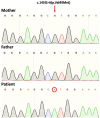Case report: Functional characterization of a de novo c.145G>A p.Val49Met pathogenic variant in a case of PIGA-CDG with megacolon
- PMID: 36324500
- PMCID: PMC9619068
- DOI: 10.3389/fgene.2022.971473
Case report: Functional characterization of a de novo c.145G>A p.Val49Met pathogenic variant in a case of PIGA-CDG with megacolon
Abstract
A subgroup of congenital disorders of glycosylation (CDGs) includes inherited GPI-anchor deficiencies (IGDs) that affect the biosynthesis of glycosylphosphatidylinositol (GPI) anchors, including the first reaction catalyzed by the X-linked PIGA. Here, we show the first PIGA-CDG case reported in Mexico in a male child with a moderate-to-severe phenotype characterized by neurological and gastrointestinal symptoms, including megacolon. Exome sequencing identified the hemizygous variant PIGA c.145G>A (p.Val49Met), confirmed by Sanger sequencing and characterized as de novo. The pathogenicity of this variant was characterized by flow cytometry and complementation assays in PIGA knockout (KO) cells.
Keywords: CD59 antigen; CDG (congenital disorder of glycosylation); GPI (glycosylphosphatidylinositol); PIGA; exome.
Copyright © 2022 Salinas-Marín, Murakami, González-Domínguez, Cruz-Muñoz, Mora-Montes, Morava, Kinoshita, Monroy-Santoyo and Martínez-Duncker.
Conflict of interest statement
The authors declare that the research was conducted in the absence of any commercial or financial relationships that could be construed as a potential conflict of interest.
Figures



References
Publication types
LinkOut - more resources
Full Text Sources
Research Materials
Miscellaneous

